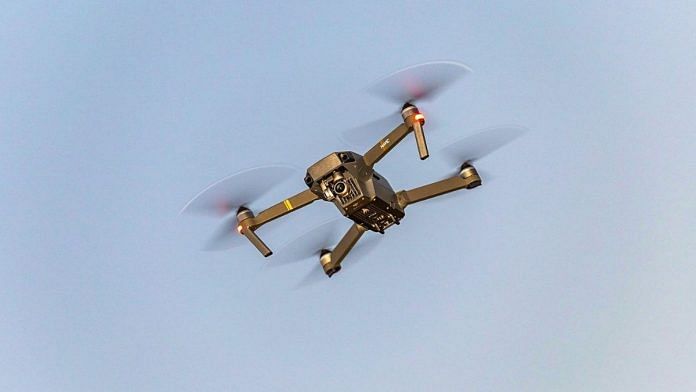New Delhi: The Indian Air Force (IAF) has sought to purchase 10 Counter Unmanned Aircraft System (CUASs) — known as anti-drone systems in common parlance — specifically from Indian vendors.
The force floated a Request for Information (RFI) to invite bids last week.
The RFI dated 28 June came after a first-of-its-kind attack at the Jammu air base, where two low-intensity improvised explosive devices were dropped from a drone, which exploded close to the station’s helicopter hangar and left two IAF personnel injured.
An anti-drone system was subsequently installed at the Jammu station.
According to defence sources, the procurement and the RFI for CUASs has been in works for the last several months.
In its RFI, the force said it is looking to procure 10 CUAS via indigenous routes. The systems are intended to “detect, track, identify, designate and neutralize” hostile drones, the RFI said, adding that a Laser Directed Energy Weapon (Laser-DEW) is essentially required as a “kill option”.
Also read: Army focuses on bridging capabilities against Pakistan & China, inducts 12 indigenous bridges
What the RFI states
According to the RFI, the system’s basic features listed include provision of a “multi-sensor, multikill solution” effective enforcement of ‘No-Fly’ zones for unmanned aircraft (drones) while inflicting minimal collateral damage to the surrounding environment.
The CUAS should also generate a composite air situational picture for the operator and generate alerts based on user defined parameters.
This means that the inputs from different sensors will be consolidated on a single screen to enable a composite understanding of the situation for the controlling agency and the commander, explained sources.
It should be possible to mount the CUAS on indigenous vehicles with cross country capability and powered by indigenous electrical power supply systems, and to transport it by air and road.
The system should have a phased array radar (for detection of the UAV); radio frequency sensor (for detecting the UAV frequency); and an electro optical and infrared (EO/IR) system for detection and tracing a hostile UAV by way of visual and heat signatures.
It should have a soft kill option, which can include a Global Navigation Satellite Jammer System and RF Jammer, and a hard kill option (Laser-DEW).
Soft kill refers to jamming the communication or navigation signals used by a drone. Hard kill refers to its physical destruction.
The RFI sought to know if the system would be able to jam radio frequency communication between the target drone and its controller, and also jam satellite-based navigation systems used by the drone such as GPS, Glonass etc.
It also asked the vendors about the range at which the Laser-DEW could destroy micro- and mini-UAVs, its dwell time, and how many targets it can engage in quick succession.
ThePrint earlier reported that the Services are yet to buy anti-drone systems in large numbers. The Navy was the first to place an order for Israeli anti-drone system Smash 2000 Plus, which turns assault rifles into smart weapons, enabling first-shot hits and anti-drone operations.
What is a CUAS?
These systems detect and intercept hostile drones and unmanned aerial systems, which can be used for intelligence gathering or smuggling contraband, or to deploy explosives.
CUASs are deployed to protect military bases, airports, critical infrastructure and other important sites.
Typically, there are two main aspects to an anti-drone system — the detection of a rogue drone, and its destruction with weapon system, or jamming its communication signals.
The detection takes place via radars, or/and radio frequency sensors and EO/IR systems. Modern anti-drone radar systems may use multiple radar technologies depending on the range required, size of the zone to be protected, and number of simultaneous targets.
To destroy a hostile drone, a CUAS can include jammers and be armed with different weapon systems. For the latter, anti-drone systems could use guns or missiles along with a targeting system to destroy a drone. Similarly a high-powered laser or microwave could also destroy a rogue drone.
(Edited by Amit Upadhyaya)
Also read: India Rafale deal under scanner in France, judge appointed to probe alleged corruption: Reports



